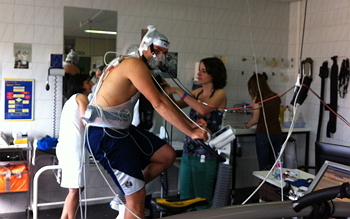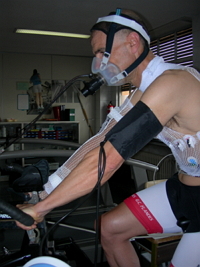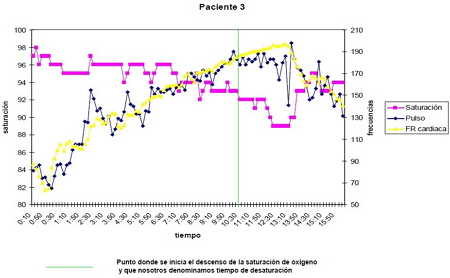NEW METHOD FOR DETERMINING PERIPHERAL OXYGEN SATURATION (SPO2) DURING PHYSICAL EXERCISE
|
Description |

Patient preparation prior to stress test.
This technology consists in obtaining physiological parameters in real-time from certain signals (photopletismographic signals) measured by optical sensors. The research group has developed a device that obtains heart rate and oxygen saturation measurements from photopletismographic signals in extreme situations, as is the case of continuous movement during exercise, and in athletes of different skin color.
|
How does it work |

Patient performing stress test.
Pulse oximetry estimates the partial pressure of blood oxygen (PaO2) from oxygen saturation (SpO2). This technique analyzes the pulsatile signal generated from the variation in arterial blood flow with the pulse generated by the heartbeat. It is applied in a continuous manner as a non-invasive technique to monitor patients throughout the process of anesthesia and intensive care, neonatal control, evaluation and monitoring of chronic and nocturnal lung disorders, and in sports medicine.
Recent studies have shown that classical red and infrared transmitters underestimate oxygen saturation in levels below 70%. The use of other wavelengths improves measurement results at these levels. This problem is of special importance in cases where these values are reached - such as fetal monitoring, sleep apnea studies, and stress tests.
This technique, applied to the fitness assessment of athletes in combination with the stress test, is a complementary and appropriate method for determining the limit of cardiopulmonary stress, characterized by a significant drop in oxygen saturation. The study of oxygen saturation progression during maximal effort by this type of oximeter along with the correlation analysis of ergospirometric variables in different sports, yields an oxygen saturation value during exercise - a key parameter in improving athletic performance.
|
Advantages |

Data obtained from the athlete performing the stress test and the oxygen saturation values obtained.
This technology has proven to be robust and insensitive to motion artifacts, resulting useful in different areas, such as physical exercise and sport. The results obtained during maximal effort stress tests, both cycle ergometer and treadmill, carried out by athletes of both gender, prove this. Pulse values derived with this new photopletismographic technology match the heart rate values obtained through electrocardiography.
With the new oximeter’s application in sport and in all kinds of athletes, improved results are obtained during a continuous stress test in comparison to other commercial oximeters currently available on the market, especially at high running speeds and at heart rates greater than 150 beats per minute, in which the movement of large muscle groups is involved.
|
Where has it been developed |
The new method based on photopletismographic signals and the new pulse oximeter designed to apply this methodology have been developed by a multidisciplinary group formed by members of the Complutense University of Madrid (Professional School of Medicine Physical Education and Sport) along with the Microelectronics Institute of Madrid (CSIC), ICAI, Pontific University of Comillas of Madrid, the University Institute of Applied Microelectronics, the Microelectronics Technology Division of University of Las Palmas, and the Pulmonology Department of the San Carlos Hospital of Madrid.
|
And also |
We are currently looking for measuring device manufacturers and marketers for the device’s use in athletes interested in improving their pulse oximetry values; especially companies working with sensors with a biomedical application.
Impact: Although there are many devices of this kind on the market, we are convinced that the reliability of our algorithm is superior and avoids the presence of inaccurate heart rate measurements.
Applications:
- Training control and management though training apps.
- Heart rate control and management in healthy individuals through training apps.
- Monitoring of the training loads of amateur athletes.
- Monitoring and control high-level athlete training.
- Control and monitoring high-altitude sport done and sports performed without oxygen (Himalayan sport).
- Control of the patient who needs exercise prescription. Similarly, we believe that this applies to the study of cardiac patients, such as patients with coronary pathologies undergoing cardiac rehabilitation processes (whose heart rate should be adjusted to physiological conditions), or in respiratory and physical therapy rehabilitation in order to adapt oxygen saturation levels during exercise, as well as in other metabolic diseases such as diabetes, etc. where a scheduled exercise prescription regarding heart rate oxygen saturation, and therefore of lactic acid levels, is necessary.
|
Contact |
|
© Office for the Transfer of Research Results – UCM |
|
PDF Downloads |
|
Classification |
|
Responsible Researcher |
María del Pilar Martín Escudero: pmartinescudero@med.ucm.es
Department: Physical Medicine, Rehabilitation Medical Hydrology.
Professional School of Medicine of Physical Education and Sport.


